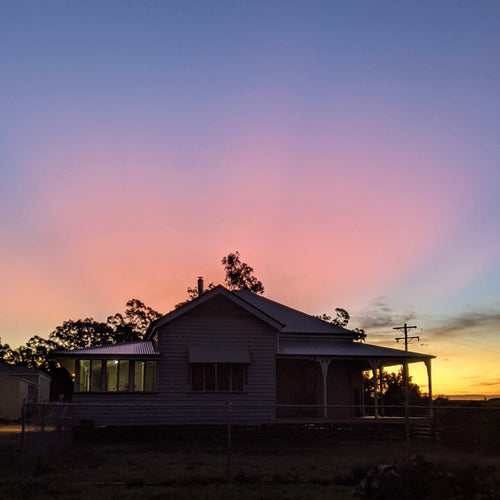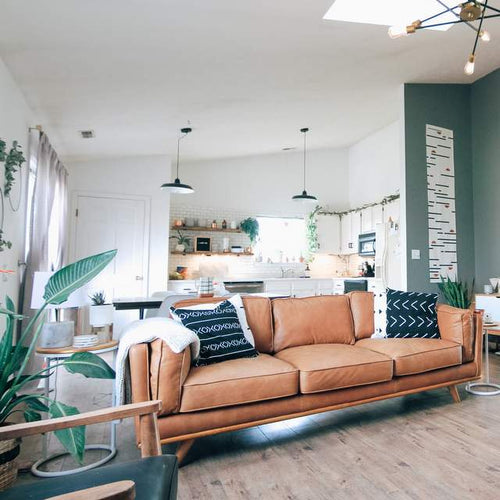Keeping our house cool in summer
As Australian summers seem to be getting hotter and electricity prices are increasing, we need to look for passive techniques to keep our houses cool instead of reaching for the air con remote. For those living off-grid, this is always a consideration. When you understand how heat gets into your house, the solutions are clear, and there are a number of options to suit all budgets. We moved a 100-year-old house on to our property about six years ago and took a number of steps to ensure that we would not require air conditioning, even though it had been essential in our previous house nearby.
Heat transfer
There are three ways that heat is transferred from the outside to the inside of your house in summer (and in reverse in winter): conduction, convection and radiation. Conduction is heat transferred through the materials of your house. First the cladding or the roof heats up, and that heat is conducted through to the interior walls. Convection is the heat transfer by movement of the air, so hot air leaking into the house through poorly sealed windows, doors and floorboards. Finally, radiation is the direct and reflected heat from the sun that comes into the house through windows and glass doors.

Conduction
Conduction is prevented through insulation in walls and under rooves. We have fully insulated our roof space using rock wool insulation (polyester is another option). Over time, the insulation will compress and become less effective, so it does need to be checked and replaced eventually. We have also put insulation into any wall space that was exposed during renovations. Another option is to put insulation under floors of raised houses (or in slabs); however we chose to put hardwood floorboards over the existing pine floor, which has provided some insulation (simply by increasing the thickness of the floor).

Conduction can also be controlled by choosing light coloured finishes that reflect heat. We replaced the old red roof with a lighter colour (Colourbond Paperbark) which noticeably reduced the temperature under the roof. And we painted the exterior of the house in a light colour (beige). Even though this is not the most striking and attractive combination of colours (I notice that most houses are either dark roof with light walls or visa versa), it has been practical in terms of reducing conduction heat transfer.
Radiation
If you are lucky enough to be starting from scratch, the best way to keep your house cool is by designing it to be orientated to avoid the sun shining into windows in summer. This means using a veranda or awnings over any north-facing windows, minimising windows on the western side (hot afternoon sun) and making use of the shaded southern side. When we moved our house, we orientated it so that the long veranda faced north and the bedroom windows on that side of the house are all shaded in summer. On the opposite side of the house, the enclosed veranda is one long row of windows, which is facing south out of direct sun.
Even though the room with the windows is facing south and all the windows are tinted glass, we found that we had significant reflected sunlight from the driveway, and this room was still getting hotter than the rest of the house. The best way to block direct or indirect radiant heat is from the outside of the window using blinds or awnings; however, this was not possible on this side of our house (this may be an option to retrofit an existing house that is poorly orientated). The other option is to use blinds or curtains inside the house to block the radiation. I decided to invest in roller blinds (12 in total, custom made to fit the windows) instead of air conditioning (about the same cost) as I knew that the blinds would last a long time and have no running costs. I also have long curtains throughout the rest of house, which we keep these closed during the day in summer.
Convection
Convection can be used to your advantage to cool the house depending on your climate. If you have low humidity and cool nights, you can open the house up when it’s cool outside and use natural convection (breezes) as well as fans, to displace hot air in the house. We are lucky to have windows in strategic locations that allow cross-breezes throughout the house, including breezeways over our doors (note that fly screens are essential in country areas to avoid a house full of bugs on a summer evening!).

When it gets hot, you want to seal all the draughts to keep the hot air out of the house. Aluminium windows and sliding doors generally seal well, old wooden windows and doors do not. You can buy sealing strips for wooden doors and I also use draught snakes (made from the bottom of curtains that were too long and filled with kitty litter).
In higher humidity climates, it doesn’t cool down so much overnight, so there is less advantage in sealing the house. In this case, it makes more sense to have as much airflow as possible by opening doors and windows during the day. You can also hang a wet sheet over a window to take advantage of evaporative cooling – air cools as the water is evaporated from the sheet. When we had our neighbour over with his bulldozer to form our driveway, I also asked him to build a dam on the southern side of the house. This dam is between the house and a bush area, so it serves as a bushfire barrier, but it also helps us with cool breezes coming off the dam and through the house on the side where we can open all 12 windows.
Does it work?
We have spent two summers in the house and only on a couple of particularly hot and still nights have I wished for air conditioning. Generally, the house is comfortable enough to sleep at night. During the day, the house stays cool enough with the curtains and blinds closed to block radiant heat, and with our insulation and light coloured walls and roof. At night, it usually cools down enough with all the doors and windows open and ceiling fans in every room to circulate cool air. The worst part is the noise of the frogs in the dam on a summer evening, which can be deafening with all the doors and windows open!
Do you have air conditioning? How do you keep your house cool in summer?
A secondhand house for Cheslen Rise
A tour of our secondhand house (BEFORE)
The story of our secondhand house - Part 1
Choosing insulation for our house
Renovating a Queenslander house
Building the Queenslander house - book review
Stairs for our secondhand house
Removing asbestos from our secondhand house
Another update on our house progress
How to choose exterior paint colours
And one more update on our house progress
Keeping our house warm in winter























The house and property looks great! Nice to see a full dam. The ones in our area, are all full too. No air-con here. Simply not enough reliable water and even if I had a bore, I don’t think I’d want to get air-con. Many of the neighbours have it and I can hear it going, when I dare to go outside to water the plants. It’s just one of those tech things, I like to avoid if I can. Tech is great when it’s working. Sucks when it’s not, and then you’re back to square one until repairs are arranged.
Having my kitchen garden on the northern side of the house means, when I water it and the concrete verandah ends up getting wet too, it creates a cooling effect, in the back sliding doors. I generally save this until the afternoon, so I can stand to open the doors, but it cools down the house, that little bit quicker.
Leave a comment